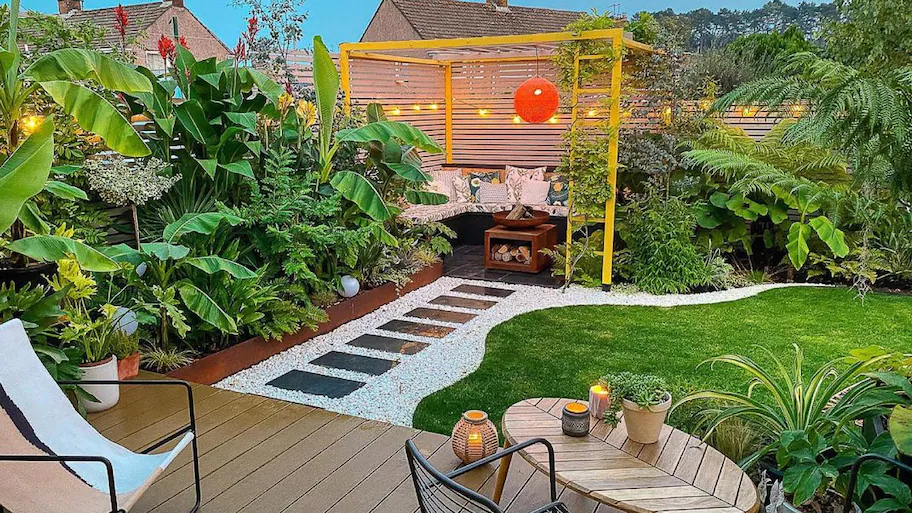Consider the color, texture and bloom time of your plants when looking for low maintenance garden border ideas. You’ll also need to consider whether or not the border will be close to a driveway, path or walkway or if the border will be tucked away in the back around a garden area. Learn about low-maintenance border ideas for your garden that fit your climate, growing zone, size, shape, and style.
What To Consider When Choosing Low-maintenance Garden Border Plants
- Keep it simple by using blocks of color.
- Plant annuals and perennials that will come back year after year.
- Select low-growing groundcovers that don’t require much pruning.
- Search for drought-tolerant plants.
- Consider using stone or other edgings to keep your border neat.
1. Use Color Block Design
A garden border can be made more striking by using large blocks of color. Ajuga and Anemones create a vibrant violet-blue color in this flowerbed. The border is the best place to use it for maximum impact. Try forget-me nots, which are a pale blue flower that blooms profusely during spring. Deadheading them will keep them from spreading too much but the new plants can be easily pulled up.
2. Showcase Spring Bulbs
Spring bulbs offer a variety of options for a three-season display of beauty and blooms. These bulbs are perfect for a spring garden with a lot of color, such as this one that has daffodils and tulips at the borders. As your bulbs die off (in April or May), you can plant more perennials. Plants with small roots and foliage that is raised off the ground are good choices for planting near bulbs. These include hostas and daylilies.
3. Bring Colorful Foliage to the Front
Colorful foliage is a low-maintenance way to add color in the front border. Artemisias have silvery tones; heucheras are available in a variety of colors; euphorbias can be found in a wide range of textures and colors. Lower-growing sedums offer a selection of foliage colors including blues, grays, purples and greens. Silver tansys (Tanacetum haradjanii) and Euphorbia Myrsinites combine their blue-grey tones and chartreuse colors. Caladiums and coleus are two annuals with colorful leaves.
4. Add a Shaded Border
Shade gardens need not be colorless. This circular shade garden has a border that is adorned with burgundy Heuchera, variegated Euonymus and light green ferns.
5. Mediterranean Style
Herbs thrive in the mild climate of southern Europe. Consider some aromatic culinary herbs to grow along your border if you have sandy soil, plenty of sun and a warmer growing zone. If you have the right conditions, many useful herbs can be grown as perennials. These include oregano and thyme. The huge plants that overflow the walkways in these lavender gardens create a fragrant paradise for the visitors.
6. Play with Height
Tall plants can also work. Choose plants that have a small, airy crown to allow for the view of plants behind. You can choose from agapanthus (pictured above), alliums (pictured below), camassia (an early autumn bulb), heucheras (pictured below), flax (pictured above), anchusa (“Dropmore”), delphiniums (pictured), rose campion (pictured), anemones and globe thistles. The annual cosmos is a tall flower with delicate flowers and feathery stems.
7. Add Low Hedges
The paths in this lush garden in Sweden connect different areas. This path has short, chunky hedges of boxwood that are neatly clipped. The angular shapes complement the organic and round shapes throughout the garden.
8. Plant Perennial Mums
Perennials that bloom late in the year are a great way to keep the show going. Perennial mums provide a steady supply of vibrant color. Order them in spring from a reputable nursery for fall blooms, and they will grow in size every year. This striking contrast between yellow zinnias, purple mums and acorns makes a stunning autumn border.
9. Select drought-tolerant border plants
There are many options if you live in a desert or dry climate or just want a border that is more drought resistant. You can create a low-maintenance border with succulents such as creeping sedums, hens and chickens, and euphorbias. They spread rapidly but not aggressively, and they come in many varieties that flower. This California garden includes drought-tolerant plants such as yarrow (flowering catmint), euphoria and nepeta.
10. Include Creeping Plants to Create an Organic Look
The border can be enhanced by creeping plants such as euphorbias, coreopsis (especially the spreading variety ‘Firewitch’), dianthus, thread-leaf sedums or short Asters (such as ‘Wood’s Blue’). These plants will spill over in an attractive way and create a natural-looking design. Deadheading will keep your perennials neat and tidy. It also encourages them to bloom more. This dianthus, for example, will produce a second or third round of flowers after the spent blooms are removed.
11. Use Uplifting Miniatures
There are many perennials that come in dwarf or miniature forms, such as irises. (The pictured irises is ‘Bright Blue Eyes.’), daylilies and roses. These shorter plants allow for more options for perennials to bloom in the front border for three seasons.
12. Create a Green Border
This border is shady and features plants with green leaves, including heucheras, hostas, and variegated Irises. Not only are there different shades of green, but also stripes, spots and edges. These plants also produce colorful flower.

